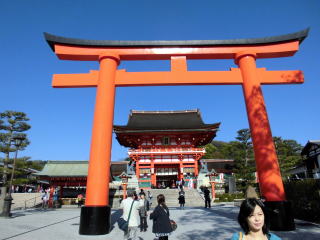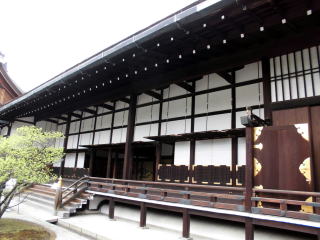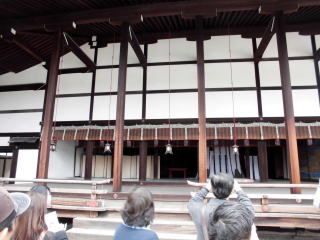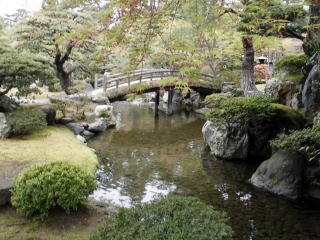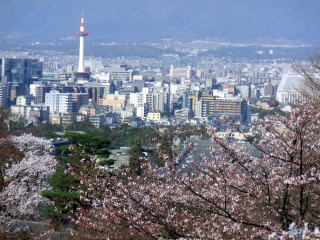KYOTO, THE SECOND CAPITAL
ASHIKAGA takauji, the first shogun of Muromachi shogunate founded the temple in 1343
in order to console the spirit of ex-emperor GODAIGO, who perished with
grief in 1339 in Yoshino.
It is registered as world heritage and located next to the famous bamboo
truck in SAGANO.
Kyoto was the second capital of Japan from 794 to 1869 AD for more than
1,000 years
after Nara. Now Kyoto is a modern and classic city with many temples, shrines
and
historical places. There you appreciate glamours culture and tradition
as well as
modern technology. What's more, Kyoto is now seventh major city with population of
1.5 million. Accordingly, it charms and attracts more than 8 million tourists
each year.
HISTORY:
623 Temple Koryuji was built in Yamashiro region.
794 The capital was transferred to Yamashiro region (now, Kyoto).
804 The capital "Heian-kyo" was completed in construction.
960 The Imperial Palace was destructed by fire.
1177 Great fire destructed the capital.
1336 ASHIKAGA Takauji opened Muromachi shogunate, the second regime of
Samurai.
1467 ONIN-NO-RAN, great civil war broke out in Kyoto
1563 ODA Nobunaga restored peace in Japan after civil war of 100years
1583 TOYOTOMI Hideyoshi started governing Japan and Kyoto restored its
glory.
1869 The capital was transferred to Edo renamed eastern Kyoto (called Tokyo).
1, Fushimi-Inari shrine
The shrine was constructed in between 708 y 715, and worships the deity
of good crop of
five kinds of cereals with Inari(fox) as divine messenger for successful
business and traffic
safety. It has tunnels of vermilion toriis of several kilometers long
on the slope up to
the top of the mountain, which shows fantastic and mysterious view.
As a result the shrine is the most popular place in Kyoto among many tourists.
Passage to the base de the main keep
View of Ninomaru buildings from on the base of
the main keep
Garden behind Ninomarru was constructed
by KOBORI Enshu
At the entrance of Daihojo
Main hall " Daihojo"
Sand garden and main hall "Daihojo" at left
Mansion Minomaru
The pond "Kyoyouchi with cherry trees
Sand garden with some tourists
Rooms with tatami mats
The entrance of the temple
The terrace is 20 meters high with
cherry blossoms.
Panoramic view of Kyoto from the terrace
Kiyomizu temple with its terrace
Slope with moss in the garden
Nomiya shrine where bamboo track starts.
Rikisha and tourists
Honden, main sanctuary
The second torii
Some tourists enjoy walking along the track.
Kiyomizu Buddhist temple, one of the oldest temples in Kyoto, was founded
in 778 and
registered as world heritage with UNESCO. It is always full of many tourists
and
we can look over Kyoto from its famous terrace.
7, Ryoanji Buddhist temple
8, Nijo castle
9, Tenryuji Buddhist temple
Sakura gate to the sanctuary
Thousand toriis in series
Other tunnels of toriis with contributor's names and dates of donations
2, Bamboo track in SAGANO
There is a fantastic bamboo track of hundreds meters long behind Tenryuji
temple, world
heritage, which was constructed by ASHIKAGA Takauji, the first shogun of
Muromachi
shogunate in 1345. We can encounter a very typical Japanese view in silence.
3, Old Imperial Palace (Kyoto Gosho)
This Old Imperial Palace was constructed in the mid of 16th century and
emperors had lived
there until 1869 before the transfer of the capital to Edo (Tokyo).
Shishinden with the thrones of emperor and empress inside
The Building , private residence of emperor and empress before 16th century
Ogakumonjo where cultural events were hold and emperor made audience
with noble men.
Gonaitei garden
Otsunegoten, private residence of emperor
since the end of 16th century
4, Rokuonji Buddhist temple (i.e. Kinkakuji pavilion)
Rokuonji Buddhist temple is known as Kinkakuji (golden pavilion) and its
structure represents
those of 14th century and Kitayama culture flourished in Muromachi era.
Third shogun, ASHIKAGA Yoshimitsu of Muromachi shogunate constructed a
villa,
Shariden in1397 which converted in Rokuonji temple after his death.
The pavilion was fired in 1950, reconstructed in 1995 and registered on the world heritage
list of UNESCO as cultural asset in 1994.
Gold pavilion and pond
5, Jishoji Buddhist temple ( i.e. Ginkakuji, silver pavilion)
Jishoji Buddhist temple is known as Ginkakuji (i.e. silver pavilion) and
was constructed
by ASHIKAGA Yoshimasa, 8th shogun of Muromachi shogunate in 1490 modeling
after the golden pavilion. It was registered on the list of world heritages
of UNESCO in 1994.
Silver pavilion
Sand garden
6, Kiyomizu Buddhist temple
Crystal water (Kiyomizu) falls and visitors scoop it
with ladle.
Ryoanji is one of Zen Buddhist temples constructed by a great feudal lord, HOSOKAWA
Katsutoshi, feudal lord in 1450 and registered as world heritage by UNESCO.
The temple is very famous with its sand garden of 15 rocks, which is 22
meters
wide and 10 meters long. The sand represents sea and the rock islands.
This castle was constructed by TOKUGAWA Ieyasu, the first shogun of TOKUGAWA
shogunate
in 1603 as residence and office in Kyoto, and registered as world heritage
on the UNESCO
list in 1994. In the castle the ceremonial party of appointment as shogun
was held in 1603
and TOKUGAWA Yoshimune,15th shogun announced the return of political power
to
the emperor in1867. It means that Edo era started and finished at the castle.
The gate "KARAMON" to the mansion Ninomaru
One of the castle towers and moat
Tahoden temple
Sougen pond and sand garden
Paper sliding doors with a picture of Dragon
